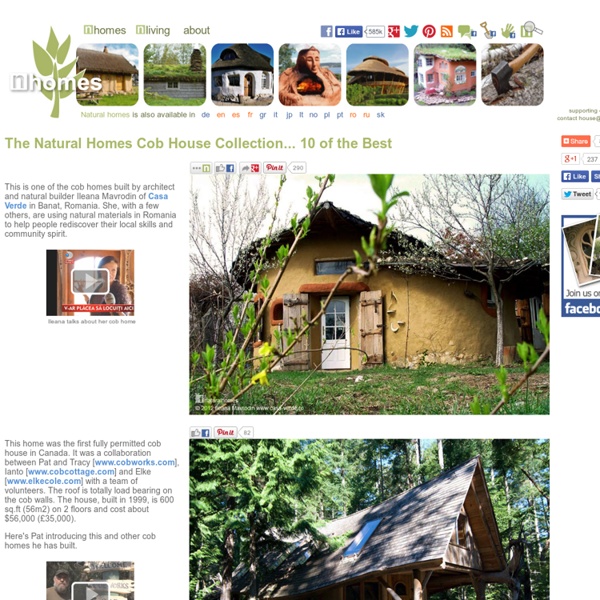



A beautiful cob home in England Which means, "Where are you going? It's getting dark, so come in and take a drink". If you're interested in English accents you can listen to the Somerset accent on the BBC The home is the work of Lisa and Rich who built the house with clay from the stream that runs just out of view in this picture. If you want to build with cob then you must test the quality of your clay. Make compact balls of the mixes about 6cm diameter.
untitled musgum earth architecture feb 18, 2010 musgum earth architecture designboom has dedicated a large amount of time to learn more about clay - one of the earliest natural building materials in history of men. our intent is to promote earth also as a building material of the future. it represents an excellent alternative to cement whose manufacture releases considerable quantities of CO2. individual housing units and small apartment buildings can easily be built from earth in every part of the world. however, concrete remains an essential material for high-rise construction. the research effort should be therefore two-pronged: tailoring earth to the needs of modern construction and making concrete ‘greener’. in this first article of a series, which we will publish in the upcoming weeks, we’ll examine a few ancient building techniques. musgum clay houses in cameroon what strikes at first sight is their almost organic simplicity, a second reading reveals the functions behind the forms. detail drawing of a musgum dwelling
untitled Dig these 6 awesome underground homes Okay. So the $1.7M Cold War era underground home in Las Vegas is ghastly and depressing. But you will be amazed at how striking a buried abode can be if designed skillfully. Behold, six subterranean homes that you don’t need to be a paranoid hermit to appreciate. Berber homes, Tunisia Pictured above is Hotel Sidi Driss, a traditional sunken Berber building in the village of Matmata, Tunisia. Tunnel villa, Switzerland Designed by SeARCH and Christian Muller Architects, this tunnel-shaped home was built 72 feet (22 meters) into a slope on Switzerland’s Valsertal Valley. Cave house, Missouri This two-storey, three-bedroom home in Festus, Missouri was built inside of a 15,000-square foot sandstone cave. Malator, Wales The Malator, or Teletubby House as it’s known locally, blends into the hills that overlook St. Earth House Estate, Switzerland Earth House Estate Lättenstrasse in Dietikon, Switzerland is as close to a real-life Shire as you’ll find. Aloni, Greece
untitled The Brick Bake Oven Page Click here to order. by Daniel Wing and Alan Scott Definitive work on authentic hearth breads. Includes instructions for building a backyard bake oven. "Wing and Scott do more than get the details right: they get the right details. Woodfiredpizza.org Good site with instructions for an Alan Scott style oven. August Vanderdonckt's detailed photo record of building an Alan Scott oven. Frankie G's Pizza Oven Project - good photo record and pizza info. Step by step Alan Scott style oven at backyardbrickoven.com Build Your Own Earth Oven (3rd Edition) Click here to order A simple, fully-illustrated handbook for making an oven from earthen materials (similar to adobe and cob). Provides clear, step-by-step instructions for building and firing the oven. Check out Kiko's great blog and archive on oven building on ovens and earth art Backyard adobe - We built this simple oven at our neighbour's 20 years ago. Click on image for assembly photos. Frank's Pizza Oven Instructions for building a loam oven.
untitled Cob Oven Adventure | Kitchen Dancing 19 Apr In the fall our good friend Amy emailed us this article, The 36-Hour Dinner Party by Michael Pollan because she thought it would be right up our alley. Josh read it right away, fell in love with the idea, started enlisting friends to join us in this adventure and for months has been urging me to read the article and get on board too. The inspiration is this: Pollan, along with some friends built a single wood fire in a cob oven and cooked 4 meals over the course of a couple days. I finally just read the article. Anatomy of a Cob Oven - Image from urbanhomestead.org One major difference though: Pollan conveniently had a friend with an already existing cob oven. Some of you may be asking yourselves, “What the heck is a cob oven?” I bought Josh this book titled, Build Your Own Earth Oven for his birthday in February and we’re in the planning stages now. Like this: Like Loading...
untitled LE COB D’après les dictionnaires : Cob (cobb, clom termes anglo-saxon) ou bauge (terme français). Système constructif monolithique en terre crue. Un peu d’histoire… Nous pouvons remonter les origines de cette technique à des temps préhistoriques. Et aujourd’hui … Le cob c’est : Un mélange qui sculpté à la main, nous permet de faire les murs de nos maisons, cabanes, toilettes sèches ou fours (certaines couches)… et de passer des moments incroyables de création entourées de notre communauté. -Terre argileuse : la plupart du temps, nous trouvons de la terre suffisamment argileuse sur le terrain du chantier. -Sable : Si possible d’une carrière proche. - Une fibre : La paille en ce qui nous concerne. - Eau : L’eau rajoutée au mélange permet à l’argile d’aller enrober tous les grains de sable et les brins de paille. Nous mélangeons progressivement ces matériaux à l’aide de nos mains et nos pieds. Avant que le mur ne soit trop sec, on peut revenir sur des bosses à l’aide d’une vieille scie. Pour cela :